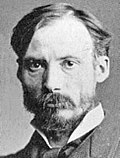English: La Grenouillère, the frog pond was a popular venue for outings from Paris and for bathing in the summer, situated outside Bougival to the west of the capital. The sun is filtered through the green leaves and it sparkles on the surface of the river Seine. People are bathing. Some are in boats, rowing or sailing on the river. A group of men in suits and women wearing crinolines have sought shade beneath a tree on the little artificial island known as Camembert or the flowerpot.
It is the summer of 1869 and the painter Auguste Renoir and his colleague and friend Claude Monet are spending some days together. They paint the same subject. They compete to see which of them can most rapidly capture his subjective impressions of what he sees on canvas. Renoir's painting is made up of short and quick brushstrokes using colours straight out of the tube. It is an instant impression caught in a shimmer of colours and reflections from the water. To his contemporaries the painting seemed unfinished; a mere sketch. But today we consider it a textbook example of impressionism.
The impressionists’ rapid, sketchy way of painting – their desire to portray their impressions directly on the canvas – was something new. They were breaking with a tradition and they challenged the artistic taste of the times. La Grenouillère represents not only a new way of painting. The subject chosen was also new. They portrayed modernity, la vie moderne, with its commercial and public life. They painted the new department stores, the cafés, the parks and theatres. The male artists were flâneurs, people who wandered randomly about the city observing it. For them, Paris and its environs was a public stage.
This stage was entirely segregated as to gender and class in a way that we are often hardly conscious of today. One example of this is to be found in the perspective on the city that one finds among the women impressionists; for example in paintings by Berthe Morisot and Mary Cassat. They portray the city from balconies or a box at the theatre. It was not possible for them to observe street life like the flâneurs; and there were no flâneuses. The gaze of the flâneur is an expression of masculine heterosexuality with freedom to see, to value and to own in fact or in imagination. The role of prostitution in modernity, accessibility to the women of the poorer classes, figures prominently in their paintings.
Subjects that we can experience as idyllic today had a very different meaning to people at the time.
In Guy de Maupassant's short story La femme de Paul from the 1880s we find a very different picture of La Grenouillère:
The water-side café was terribly noisy. Rivulets of beer ran across the tables between half-empty glasses and semi-inebriated people. […] The men sat there with their hats on the back of their heads and their florid, red faces and watery eyes; […] The women, looking for the evening's catch, accepted glasses of beer or wine in the meantime […] The whole place stinks of stupidity, of the rabble, of love for sale.
[2013-10-04] Webbtexten sv inlagd ; eng Teknik / Material och eng Förvärv inlagt. Från webbutställning Det Moderna Livet [ABD]









